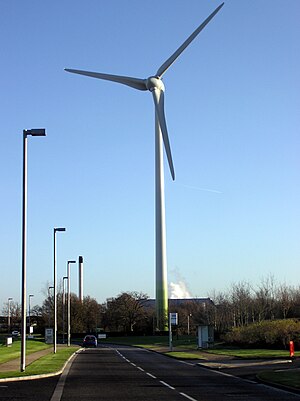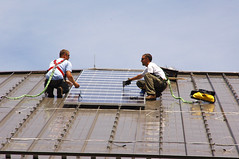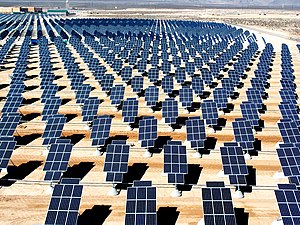In the true spirit of humanity, we've begun to do what what we always do whenever there’s something that does not completely satisfy us about life: we innovate.
Alternative home energy sources are becoming more popular every year, as prices increase and we become more aware of the impact of fossil fuels on the environment. (Ironically, many of the sources that people think of as "alternative energy" have actually been around even before electricity was discovered.)
Consider these types of alternative home energy:
| (Photo credit: Wikipedia) |
Yes, the windmill was indeed, used to mill grain. As you may well know, grinding grain my hand is very hard work. So in order to make life more convenient and the production of flour more efficient, windmills were used to turn the large grinders.
The wind is a free (and in some places abundant) resource, so I suppose it was inevitable that the windmill evolve into the 21st century to be used as a power source.
2) Solar energy – Many people think of this type of alternative home energy as something that’s technologically advanced. In a sense, harnessing the power of the sun to produce electricity is. But this "alternative" home energy source has already been in use for a long, long time.
Think about this word for a second: clothesline. Aha, you get it now, don’t you? Yes, we have been using solar energy to dry our clothes for God knows how long. Think about that spin dryer or hair dryer you have and think about how much electricity it uses to do a task that the sun has been able to do for years, albeit at a slower pace.
This alternative home energy source is harnessed nowadays for a variety of tasks. Some use it to heat their homes, others use solar power to heat water, and other people use solar cells to power small appliances and save a little on that electricity bill. The efficiency by which we are now able to convert solar power into electricity is of such a degree that it is very possible to power a whole house! It's pretty amazing if you think about it.
3) Hydropower – This type of alternative home energy makes use of water currents in order to turn turbines to run generators. Once again, this is not really a new technology. Like windmills, waterwheels were often used to harness the power of a nearby river in order to grind grain into flour - again, before we had electric pumps or grinders.
4) Biogas – This is another alternative home energy source. Biogas is produced naturally via the decomposition of different biological material. By using biogas instead of the common LPG, home owners can often cut back on their heating bills.
| Renewable energy sources at homestead in Chattlehop. (Photo credit: Wikipedia) |
Unfortunately, some of the methods of harnessing these different alternative home energy types may yet seem impractical to the common homeowner. However, as technology continues to evolve, you can be sure that the use of alternative energy will become more and more efficient.
By using alternative home energy, you accomplish two things: you save on your expenses and you help create a better world. Using these alternative energy sources minimizes the impact on the environment, and by using these sources, in many cases you can harness relatively free energy. Some people may say that the devices used to harness these sources may be too expensive, but in the long run, you’ll end up saving so much more than you spend.














